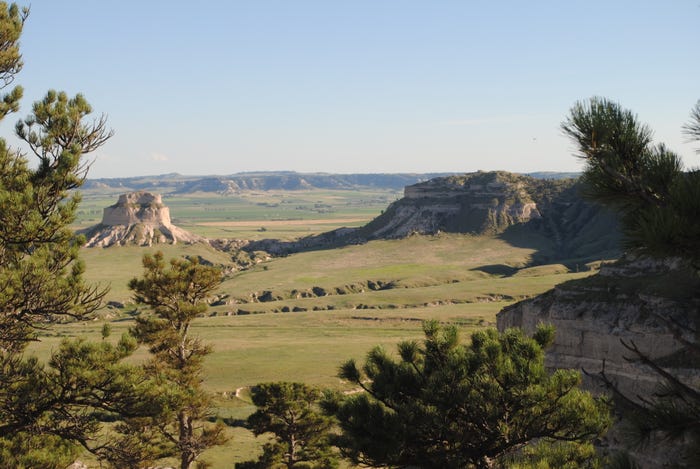
If you climb to the highest point in Nebraska, you are really up in the air. Of course, the state’s highest “mountain peak” is not a peak at all, or even a small hill. Panorama Point in the extreme southwest corner of the Panhandle in southwest Kimball County is more like a rise on a flat plain, but at 5424 feet above sea level, it is at a high elevation, at least for Nebraska. On a clear day, “climbers” of the point are rewarded with a view of the Rocky Mountains to the southwest. Panorama Point ranks first among the highest spots in the state, but ranks as only the 22,675th highest spot in the U.S., according to peakery.com.
That is not to say that Nebraska terrain doesn’t have its share of peaks and valleys. Travelers who never venture off Interstate 80 speeding across the state miss out on the ruggedness and beauty of our rural landscape, and they miss our mountains. Any rancher in the Pine Ridge, Niobrara River valley or Wildcat Hills who has been busy repairing fences after wildfires or keeping cattle on grazing land knows firsthand the mountainous and rugged terrain of those regions.
Most sources say that there are between 150 and nearly 180 “mountains” in the state. While none of these can capture the grandeur of the Rockies, Nebraska’s mountains, buttes, hills, tables, peaks, rocks, knobs and knolls have great rural character and interesting stories behind them.
What’s in a name?
Not only do the state’s mountaintops have character, located mostly on private farms and ranches, they also have memorable names. You have to love the state’s number two peak, Hogback Mountain near Scottsbluff, which rises to 5069 feet. You have Lovers Leap Butte and Eagle Eye Rock near Crawford. Nebraskans are familiar with Pants Butte and Scotts Bluff. At Scotts Bluff and Mitchell Pass, there are actually five known peaks including Eagle Rock, Sentinel Rock, Crown Rock, Saddle Rock and Dome Rock.
Among the more interesting names in the state are Big Haystack Mountain, Rifle Sight and Smokestack Rock. And of course, there is Happy Jack Peak rising above the North Loup River valley at Scotia, and above the 6000 feet of honeycombed caverns in the Happy Jack chalk mine below. At 3789 feet, Toadstool Geologic Park in the Oglala National Grassland north of Crawford may not include any mountain peaks, but this interesting place in Nebraska’s badlands is named after its unusual rocks that once resembled huge toadstools. Many of the formations have since fallen from their natural pedestals from weathering and erosion.
Perhaps the most recognizable peak among Nebraska’s known mountains is Chimney Rock near Bayard. At 4114 feet, Chimney Rock might only rank 62nd out of Nebraska’s peaks, but it is a famous historical landmark along the overland trails to the West. No other natural feature was mentioned so much in written diaries and verbal histories of the Western emigrants who traveled the Oregon, Mormon and California trails. Courthouse and Jail Rocks to the east at Bridgeport also held significance for Oregon Trail travelers. They could see these monuments rising in their horizon, so they would often take off on foot to try to reach the famous landmarks. Not recognizing the ultimate size of these features above the plains below, they could walk for hours in exhaustion before finally reaching their base.
History lesson
Rising to 4400 feet above sea level, the Cheyenne Buttes at Fort Robinson in the Pine Ridge are famous because they were part of the dangerous escape route take by 150 Cheyenne who broke out of the barracks at Fort Robinson where they were being held in 1879. A 12-day running fight between the fleeing Indians and soldiers from the Fort left 64 Native Americans and 11 soldiers dead.
Of Nebraska’s mountains, some of the buttes have unique names, like Coffee Mill Butte or Giants Coffin Butte in the Pine Ridge. There are several “bald” references, including the well-known Old Baldy or Tower, rising to an elevation of 1585 feet along the Missouri River north of Lynch. This is where the Lewis and Clark expedition spent an entire day in 1804 trying to drown a prairie dog, which they called a “barking squirrel,” out of its den. They were finally able to capture a prairie dog and were able to send it back alive to President Thomas Jefferson.
Animals play a prominent role in the naming of the state’s peaks, including Rattlesnake Hill, Skunk Hill, Antelope Peak, Wolf Butte, Wild Horse Butte, Bear Hill and Sheep Mountain. Many of the state’s highest points were named for local heroes, legends or, like Red Cloud Buttes, Native American chiefs. They were named for interesting characters, unusual formations and for similarities to other things around them.
Local farmers and ranchers may take these outcroppings and peaks for granted, because they work near them and among them in their operations every day, but there is a certain grandeur in the state’s highest points. While Nebraska may not have the mountain peaks of the Rockies, the state’s known peaks have great character and tales to tell. For more information, go to visitnebraska.com.
About the Author(s)
You May Also Like






